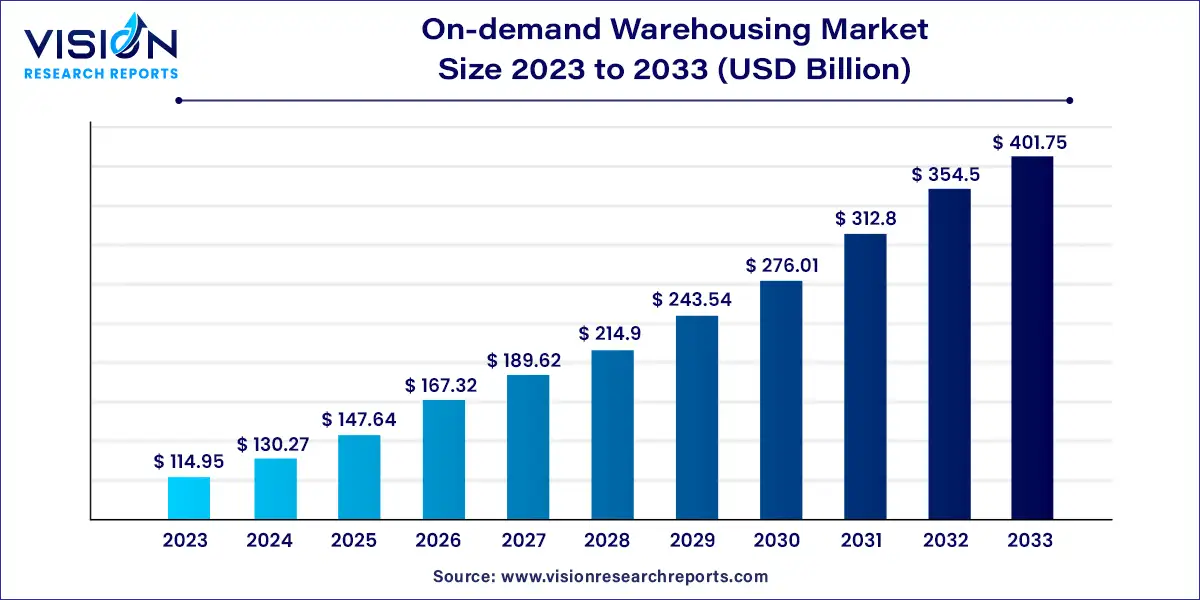The global on-demand warehousing market size was estimated at USD 114.95 billion in 2023 and it is expected to surpass around USD 401.75 billion by 2033, poised to grow at a CAGR of 13.33% from 2024 to 2033. The on-demand warehousing market is experiencing rapid growth due to the increasing demand for flexible and scalable storage solutions. This market caters to businesses that require temporary or short-term warehousing services without the long-term commitment of leasing traditional storage spaces. By providing a dynamic storage model, on-demand warehousing is revolutionizing logistics and supply chain management across various industries.

The on-demand warehousing market is flourishing due to the rapid expansion of e-commerce is a major driver, as online retailers require flexible storage solutions to handle fluctuating inventory levels and seasonal peaks without the burden of long-term leases. Technological advancements also play a crucial role, with digital platforms and warehouse management systems enhancing operational efficiency and allowing real-time inventory tracking. This innovation supports seamless integration and optimized logistics. Additionally, the cost-efficiency of on-demand warehousing appeals to businesses by offering a scalable, pay-as-you-go model, reducing the need for substantial upfront investment. Lastly, the demand for supply chain agility necessitates adaptable warehousing solutions that can quickly respond to market changes, helping businesses improve delivery times and customer satisfaction. These factors collectively fuel the growth and adoption of on-demand warehousing solutions across various industries.
Asia Pacific dominated the on-demand warehousing market in 2023, capturing 42% of the global revenue. This dominance is attributed to rapid economic growth, urbanization, and the expansion of e-commerce in countries like China, India, and Japan. The region's role as a global manufacturing hub requires extensive warehousing capabilities to manage the flow of goods. Rising middle-class consumer demand, especially in emerging markets, has increased the need for efficient delivery solutions. Additionally, the adoption of digital technologies such as AI and IoT is enhancing the efficiency and scalability of on-demand warehousing in the region.
| Attribute | Asia Pacific |
| Market Value | USD 48.27 Billion |
| Growth Rate | 13.34% CAGR |
| Projected Value | USD 168.73 Billion |
North America is projected to see significant growth in the on-demand warehousing market from 2024 to 2033. This growth is driven by advanced logistics infrastructure, high consumer expectations for rapid delivery, and the prominence of e-commerce. The United States, in particular, is central to this market, with companies increasingly adopting on-demand warehousing to manage complex supply chains. The need for flexible warehousing to support same-day and next-day delivery has heightened, while a strong focus on innovation and sustainability is further propelling market growth. Businesses are seeking smarter, more efficient warehousing solutions to reduce their carbon footprint.

Europe is expected to experience steady growth in the on-demand warehousing market from 2024 to 2033. The region benefits from a mature economy, high e-commerce penetration, and a growing emphasis on sustainability. Europe’s well-developed logistics infrastructure, advanced transportation networks, and focus on efficiency and reliability support the demand for flexible warehousing solutions. The increase in e-commerce has driven the need for efficient order fulfillment, particularly in urban areas with limited space. The European Union's sustainability goals are also influencing the adoption of greener logistics practices, including on-demand warehousing, to optimize storage and reduce emissions. The diverse market conditions across different countries in Europe contribute to the growth of adaptable warehousing solutions.
In 2023, large businesses led the on-demand warehousing market, holding over 67% of the global revenue share. Characterized by their expansive size, intricate supply chains, and substantial inventory volumes, large enterprises leverage on-demand warehousing to address specific storage requirements such as temperature control, hazardous materials handling, and advanced inventory management systems. This model offers the flexibility to adjust storage capacity in response to seasonal fluctuations or sudden demand spikes, providing a cost-effective alternative to long-term warehouse leases. By optimizing inventory levels and reducing warehousing costs, large businesses find on-demand warehousing solutions particularly advantageous.
Small and medium-sized businesses (SMBs) are anticipated to experience a faster growth rate from 2024 to 2033. SMBs often face limitations related to storage space, fluctuating inventory, and high real estate costs. On-demand warehousing presents a scalable, cost-efficient solution that eliminates the need for traditional, long-term leases. SMBs also benefit from value-added services such as pick and pack, inventory management, and kitting offered by on-demand warehousing providers. As SMBs expand and explore new markets, their need for flexible warehousing solutions is expected to rise significantly.
In 2023, the manufacturing sector was the leading segment in the on-demand warehousing market, reflecting its extensive need for storage solutions to manage raw materials, work-in-progress goods, and finished products. Manufacturing companies depend heavily on warehousing to ensure the smooth transition of goods through their supply chains. The complexity and scale of manufacturing operations often involve large volumes of goods requiring specialized storage and handling. The industry's focus on cost optimization and operational efficiency has driven the adoption of on-demand warehousing, which offers flexibility and scalability without long-term commitments or significant capital investment.
The retail and e-commerce sector is projected to grow at the highest rate from 2024 to 2033. This growth is fueled by the rapid rise of online shopping and the increasing emphasis on omnichannel retail strategies. Retailers and e-commerce businesses face challenges with inventory management, order fulfillment, and quick delivery. On-demand warehousing provides a flexible solution to manage these complexities, enabling retailers to adjust their operations to handle seasonal peaks and varying consumer demand. The growing expectations for same-day and next-day delivery have accelerated the adoption of on-demand warehousing, as businesses strive to position inventory closer to customers for faster delivery.
By Organization Size
By Industry Vertical
By Region
 Cross-segment Market Size and Analysis for
Mentioned Segments
Cross-segment Market Size and Analysis for
Mentioned Segments
 Additional Company Profiles (Upto 5 With No Cost)
Additional Company Profiles (Upto 5 With No Cost)
 Additional Countries (Apart From Mentioned Countries)
Additional Countries (Apart From Mentioned Countries)
 Country/Region-specific Report
Country/Region-specific Report
 Go To Market Strategy
Go To Market Strategy
 Region Specific Market Dynamics
Region Specific Market Dynamics Region Level Market Share
Region Level Market Share Import Export Analysis
Import Export Analysis Production Analysis
Production Analysis Others
Others